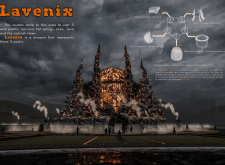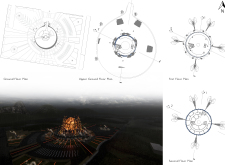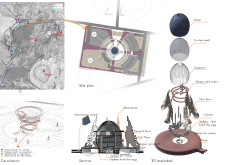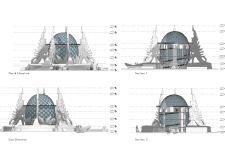5 key facts about this project
The museum is envisioned as a symbolic structure, with its egg-shaped core representing rebirth and resilience, reminiscent of the mythological Phoenix. This metaphor serves as a central theme within the overall design, inviting visitors to contemplate the relationship between nature, mythology, and architecture. Each design element, from the exterior facade to the layout, reflects the narrative of renewal and engagement with the natural world. The building itself is structured to encourage exploration, creating a dynamic path that guides visitors through various exhibits and experiences centered around the natural phenomena it represents.
In terms of its function, the Lavenix Museum operates not only as a space for displaying art and collections but also as an interactive educational facility where visitors can learn about the local biosphere and geological processes. The design incorporates several key areas: the expansive ground floor serves as the main entry point, facilitating a smooth visitor flow and fostering engagement with exhibits. As one ascends through the various galleries on the upper levels, the arrangement emphasizes each of the five thematic elements, providing immersive experiences that resonate with the museum's purpose.
Particular attention has been paid to the materiality of the project, which is essential to its architectural identity. The primary materials utilized include volcanic stone for the external spikes that evoke the region’s geological characteristics, faceted glass for the dome that allows natural light to fill the space while providing panoramic views of the surrounding landscape, steel supports that ensure structural stability, and concrete for the base, which offers robustness in harmony with the rugged topography. This careful selection of materials reflects both the aesthetic and functional aspirations of the project, blending seamlessly with its environment.
A unique aspect of the Lavenix Museum’s design is the interplay between natural light and shadow, particularly through the glass dome. The architecture has been conceived to create a dialogue with the external environment throughout the day, enabling the structure to change character as light conditions shift. This design approach enhances the visitor experience, fostering a deeper connection to the natural context while encouraging exploration and discovery.
Furthermore, the circular layout of the museum encourages a fluid circulation path that connects different sections without creating a defined hierarchy. Each visitor experience becomes part of a cohesive journey, significantly enhancing their understanding of and engagement with the exhibits. By merging architectural design with educational objectives, the Lavenix Museum stands as a testament to how architecture can serve a dual purpose: preserving and showcasing the cultural and natural heritage of a region.
The architectural design of the Lavenix Museum is not just about form; it is a considered response to the landscape, culture, and environmental considerations. This project illustrates how innovative design can integrate with the natural processes of an area, effectively making the museum an educational and cultural landmark.
For those interested in exploring more about this architectural design project, including detailed architectural plans, architectural sections, and architectural ideas that contribute to its overall impact, I encourage you to engage with the project presentation for a deeper understanding. The thoughtful presentation of these elements provides valuable insights that enhance appreciation of not only the museum itself but also the architectural practices that shape such significant cultural spaces.


























